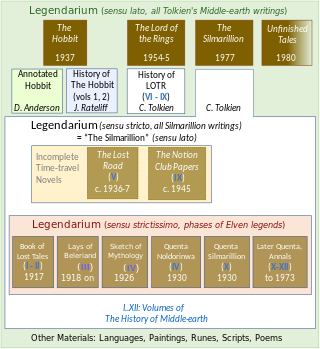Rehabilitation

21st century scholars, largely accepting Tolkien as modern, have offered a variety of estimations of his position in the literary canon, from recognising his realism in the face of the collective traumas of his time, [11] to noting his romanticism, [12] and describing the long-established elegiac tone of his writings, aligning Middle-earth with the modern world. [13]
Realism and hope
Theresa Nicolay showed in her 2014 book Tolkien and the Modernists [11] that Tolkien's Middle-earth fantasy, like Modernism, was created as a reaction to two collective traumas of the 20th century, namely industrialisation and the mechanised mass killing of the First World War. These traumas left people with feelings of hopelessness and alienation, and a sense that good tradition was broken and that religion had failed. Tolkien differed from many modernists in having a strong Catholic faith, giving him hope. Nicolay described how this combination of realism and hope guided Tolkien's Middle-earth writings. [14]
The scholar of theology Ralph C. Wood, in his 2015 book Tolkien among the Moderns , [15] argued that Tolkien was neither escapist nor antiquarian, and had engaged with modern literary figures such as James Joyce and Iris Murdoch. His book was criticised for overlooking scholarship on Tolkien's engagement with modernism, such as the work of Verlyn Flieger, Dimitra Fimi, who examined his attitudes to race, [16] and the 2-volume collection Tolkien and Modernity edited by Thomas Honegger and Frank Weinreich in 2006. [17] [18] [19]
Romantic Little Englandism
In 2005, the Tolkien scholar Patchen Mortimer commented on the "contentious debate" about Tolkien, noting that his many readers found his books and "the attendant languages, histories, maps, artwork, and apocrypha" [20] a huge accomplishment, while his critics "dismiss[ed] his work as childish, irrelevant, and worse". [20] Mortimer observed in 2005 that admirers and critics had treated his work as "escapist and romantic", [20] nothing to do with the 20th century. Mortimer called this "an appalling oversight", writing that "Tolkien's project was as grand and avant-garde as those of Wagner or the Futurists, and his works are as suffused with the spirit of the age as any by Eliot, Joyce, or Hemingway". [20]

Anna Vaninskaya, in Blackwell's 2014 A Companion to J. R. R. Tolkien , looks at Tolkien's modernity in comparison to the literature and culture of the 19th and 20th centuries. She notes that while Tolkien is popularly known as the author of two successful works, The Hobbit and The Lord of the Rings, most of his output, worked on throughout his writing career but unpublished in his lifetime, was his legendarium that lay behind The Silmarillion . She argues that the form and themes of Tolkien's early writings fit into the romantic tradition of writers like William Morris and W. B. Yeats, and have a looser connection with the Celtic Revival and with the Symbolist movement in art. In terms of politics, she compares Tolkien's mature writings with the romantic Little Englandism and anti-statism of 20th century writers like George Orwell and G. K. Chesterton. [12]
Tom Shippey, a Tolkien scholar and like him a philologist, writes that the Shire is certainly where Middle-earth comes nearest to the 20th century, and that the people who had commented that the chapter "The Scouring of the Shire" in The Lord of the Rings was about Tolkien's contemporary England were not wholly wrong. Shippey suggests however that rather than seeing the chapter as an allegory of postwar England, it could be taken as an account of "a society suffering not only from political misrule, but from a strange and generalized crisis of confidence." [22] Shippey draws a parallel with a contemporary work, George Orwell's 1938 novel Coming Up for Air , where England is subjected to a "similar diagnosis" of leaderless inertia. [22]
A mythology for an England in decline
Verlyn Flieger notes how dark Tolkien's Silmarillion legendarium is, and that "though it never wavered in intent" it inevitably changed with the changing world of the 20th century, taking on its "color, flavor, and mood". [10] She comments that his "great mythological song" began at the end of the Edwardian era, which it recalled nostalgically; took its shape in the very different era between the wars, which it viewed with "weary disillusionment"; and finally found an audience during yet another era, the Cold War, which it regarded with apprehension. [10] Shippey compares the treatment of evil in The Lord of the Rings with that of disillusioned contemporary authors after the Second World War such as Orwell, William Golding, and Kurt Vonnegut. [21] Flieger too compared him with Orwell, writing that:
If Tolkien's legendarium as we have it now is a mythology for England, it is a song about great power and promise in the throes of decline, racked by dissensions, split by factions, perpetually threatened by war, and perpetually at war with itself. It seems closer to Orwell's 1984 than the furry-footed escapist fantasy that detractors of The Lord of the Rings have characterized that work as being. [10]
John Rateliffe quotes the early Tolkien scholar Paul H. Kocher's 1972 description of Tolkien's plan, to create a mythic prehistory by inserting into The Lord of the Rings: [13]
some forebodings of [Middle-earth's] future which will make Earth what it is today ... he shows the initial steps in a long process of retreat or disappearance by all other intelligent species, which will leave man effectually alone on earth. ... Ents may still be there in our forests, but what forests have we left? The process of extermination is already well under way in the Third Age, and ... Tolkien bitterly deplores its climax today." [23]
Rateliffe writes that Tolkien's "close identification" of Middle-earth and the modern world was present throughout his writing from the start of his career to its end, as was the "elegiac tone"; Tolkien began in 1917 with "lost tales", "the fragmentary sole surviving record of a forgotten history, ... the tragic story of a ruined people". [13]
Modern but not a modernist
Vaninskaya writes that Tolkien was certainly "a modern writer", [12] but questions whether he was a modernist. She notes that whereas his friend C. S. Lewis publicly engaged with modernism, Tolkien did not. On the other hand, his work was "supremely intertextual", [12] like T. S. Eliot and Ezra Pound, full of allusions, interweaving and juxtaposing styles, modes, and genres, most visibly in The Lord of the Rings. The effect, though, was not, as those authors chose, to present modern life as "fragments in a jagged-edged collage", but "to mold an independent myth of his own", in fact to subcreate a world. [12]
Brian Rosebury, writing in 1992, quotes Tolkien's biographer, Humphrey Carpenter's remark that "Though Tolkien lived in the 20th century, he could hardly be called a modern writer". [24] Rosebury notes that Tolkien belonged to the "lost" generation that contained the killed war poets such as Wilfred Owen; but by 1954–5 when The Lord of the Rings appeared, the fashion was for anti-modernist social realism with writers like Philip Larkin and Kingsley Amis, whose "styles of calculated plainness" Tolkien did not follow. [25] In short, Rosebury writes, Tolkien had a more complex relationship to modernism, which he calls the dominant literary tendency of the 20th century. In his view, The Lord of the Rings is "antagonistic" to the practices and values of modernism, but like many modernist works it uses myth creatively and adaptively. He gives as an example Rainer Maria Rilke's Angels in the Duino Elegies , reworking the archetype of beings like humans but separate from them; the work is quite unlike Tolkien's, but like it throws mortality into sharp relief, and shows death as "a necessary and fitting, as well as a tragic, completion of our destiny". [25] He notes, too, Shippey's analysis of Tolkien's "transformations of motifs" [25] from Shakespeare's Macbeth : the march of the Ents to destroy Isengard, recalling the coming of Birnam Wood to Dunsinane; and the killing of the Witch-king of Angmar, fulfilling the prophecy that "not by the hand of man shall he fall" by bringing about his end with a Hobbit, Merry Brandybuck, and a woman, Éowyn. [26] [25] Rosebury observes, too, that like Rilke and Eliot, Tolkien builds from his "religious intuitions", creating a work that may be suffused with Christianity, but keeps it thoroughly hidden with no trace of allegory; Rosebury likens this to the way that the particularist Catholic novelists such as Graham Greene and Evelyn Waugh gave their attention to human dramas, allowing the reader to notice some power in religious faith. [25]
Sharing qualities with modernism
Rosebury states that Tolkien's writing shares several qualities with modernism, as well as having a modern novelistic "realism"; but the thing that keeps it from being called modernist is that it lacks irony. In particular, he writes, Tolkien is never ironic about value, nor about the literary text itself, both hallmarks of modernism; [25] Patrick Curry, writing in A Companion to J. R. R. Tolkien, concurs with this. [27] Shippey notes that Tolkien can all the same make use of irony, as when Denethor despairs "on the brink of victory", having been misled by looking in the Palantír. Shippey goes on to describe The Lord of the Rings as "a profoundly ironic work, so much so that I do not think we have even yet got to the bottom of its many ironies." [28]
The Lord of the Rings is sharply aware of people's moral imperfection, and all the characters, "even the wisest", understand only a fraction of their world, but the work is not radically pessimistic about the possibility of knowing anything. Rosebury notes that one can see that modernism remains influential in the fact that saying a work is not ironic or self-referential [lower-alpha 1] can be taken as disparagement, whereas in the Romantic period, works such as Byron's or Goethe's were basically always earnest. Rosebury concludes by suggesting that the "elements of neo-romantic earnestness in Tolkien may ... come to seem a welcome variant" of modernism, rather than a failure to adjust to it. [25]










